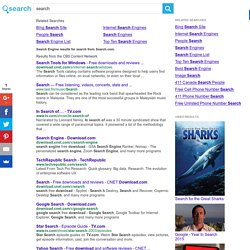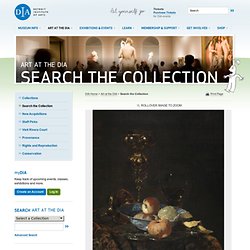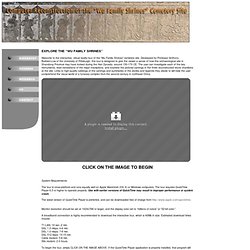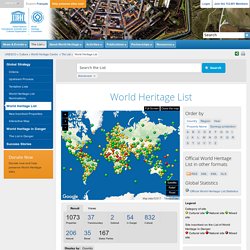

All about Islamic Arts and ArchitectureIslamic Arts and Architecture. 4000 to 1000 BCE: China.
Thematic Essay. ARTHISTORYWORLDS.ORG. The Applied History of Art and Architecture (AHAA) Educational Foundation Dr. Katherine Bolman's Micro-Lessons. Catal Hoyuk-Archeology Earlier on we saw the first dig and how things looked with just a few people working the dig.

Much has changed now as more people are interested in this small village tucked in the hills of Turkey. Lots of levels of the village are uncovered. Lots and lots of people come to the dig each spring and summer. They appear to march in an endless file. As you walk through these pictures from the dig site, you might think about becoming an archeologist. This old house: at Catalhoyuk, a Neolithic site in Turkey, families packed their mud-brick houses close together and traipsed over roofs to climb into their rooms from above. In Search of..... - TV.com www.tv.com/shows/in-search-of Narrarated by Leonard Nimoy, In search of was a 30 minute syndicated show that covered a wide range of paranormal topics.

Uruguay Cultural » Museo Gurvich además de Gurvich. Ubicado en la zona de mayor confluencia de la ciudad vieja, sobre un rincón de la Plaza Matriz y a pasos de la Catedral Metropolitana, se encuentra el Museo Gurvich, una institución dedicada principalmente a la exhibición y difusión de la obra del artista José Gurvich, con miras a la investigación artística en general. Mundo de Nueva York II, 1971 / Óleo / tela, 62 x 77 cm © Museo Gurvich - Montevideo – Uruguay El Museo Gurvich fue inaugurado en el 2005 por iniciativa de la Fundación del artista. Se trata de un emprendimiento privado de interés público que cuenta con la Declaración de Interés de los Ministerios de Cultura, y de Turismo y de la Intendencia Municipal de Montevideo. Su acervo supera las 200 obras, entre óleos, obras sobre papel, murales, esculturas y objetos, organizadas en 6 salas, en exposición permanente. Cuenta además con biblioteca, sala de lectura y tienda de regalos “giftshop “. Una guía para el ojo La última propuesta es también diseñada para la población infantil.
Willem Kalf: Still Life (26.43) — The Detroit Institute of Arts. Hope-Johnstone, C., "A Still Life by Willem Kalf", ¦DIA Bulletin,¦ vol. 8, no. 4, 1927, pp. 45-46, repr.

Denver, Denver Art Museum, "Loan Exhibition of Dutch Paintings of the Seventeenth Century", Oct. 3-30, 1929, repr (unpaginated, intro. by S. W. Heavenrich). WuShrine. During the reign of the Han emperor Wu Ti (141-187 CE), Confucianism was established as the official imperial philosophy.

The Wu family shrines, located in Jaixiang in the Shandong Providence of China, contain reliefs which depict scenes of everyday life, and serve as examples of Confucius' teachings[1]. One relief from the Wu family shrine, dating to 151 CE, depicts subjects paying homage to their emperor at his royal residence. The relief is divided into 4 horizontal sections, emphasizing the building's order and structure which thus becomes an allegorical allusion to a harmonious society based on Confucian philosophy. Center for Chinese Studies. Recarving China's Past: The Wu Family Shrines and the Story of the Stones, UCLA International Institute. Computer Reconstruction of the Wu Family Shrines. Welcome to the interactive, virtual reality tour of the “Wu Family Shrines” cemetery site.

Developed by Professor Anthony Barbieri-Low of the University of Pittsburgh, this tour is designed to give the viewer a sense of how this archaeological site in Shandong Province may have looked during the Han Dynasty, around 150-170 CE. The user can investigate each of the key monuments, read translations of the major inscriptions, and examine the pictorial carvings in the three reconstructed stone chambers at the site. Links to high-quality rubbings of the carvings and summaries of the stories and legends they allude to will help the user comprehend the visual world of a funerary complex from the second century in northeast China.
System Requirements: The tour is cross-platform and runs equally well on Apple Macintosh (OS X) or Windows computers. The latest version of QuickTime Player is preferred, and can be downloaded free of charge from T1-LAN: 10 sec.-2 min. Project Methodology: Hiroshige - 36 Views of Mount Fuji 1858. Quote: What human evolution tells us about ourselves. Human Evolution Timeline Interactive. Pre-history Africa & the Badarian Culture. A Missing Van Gogh Discovered. American Institute of Indian Studies-Photo Archive. Cultural Landscape and Archaeological Remains of the Bamiyan Valley. Cultural Landscape and Archaeological Remains of the Bamiyan Valley. World Heritage Centre - World Heritage List. #: As for 19 Natural and Mixed Properties inscribed for geological values before 1994, criteria numbering of this property has changed.

See Decision 30.COM 8D.1. Silk Road Map Quizzes. Interactive Silk Road Map Exercise This set of maps has been developed to assist learners in mastering basic geography of the Silk Road. The maps here include a variety of geographical names selected because of their importance. Obviously many other choices might have been made. The list is based on one that has been used for several years in a Silk Road survey course taught at the University of Washington. The maps have been designed by Lance Jenott in consultation with Daniel Waugh. Buddhism - The Art of Asia. The Silk Road Project - Silk Road Maps. The Silk Road. On the eastern and western sides of the continent, the civilisations of China and the West developed.
The western end of the trade route appears to have developed earlier than the eastern end, principally because of the development of the the empires in the west, and the easier terrain of Persia and Syria. Machu Picchu's Mysteries. On the morning of July 24, 1911, a tall lecturer-cum-explorer from Yale University set off in a cold drizzle to investigate rumors of ancient Inca ruins in Peru.

The explorer chopped his way through thick jungle, crawled across a "bridge" of slender logs bound together with vines, and crept through underbrush hiding venomous fer-de-lance pit vipers. Two hours into the hike, the explorer and his two escorts came across a grass-covered hut. A pair of Indian farmers walked them a short way before handing them over to a small Indian boy.
Machu Picchu.